
On Wednesday, the markets are strained with the weak dollar before US significant data are released. Investors and traders take interest in the inflation rate as it could affect the process of the stimulus tapering.
While expectations for the Fed's rapid monetary action are high, the US markets are still facing uncertainty and doubt. One party continues to believe that the Fed will announce plans to reduce its asset purchases at the November meeting, while the other party believes that the regulator will start tightening its policy no earlier than 2023.
According to Deutsche Bank, more persistent inflationary pressure will force the Fed to raise rates in December 2022. Bank strategists expect three rate hikes in 2023, followed by three more in 2024. In the end, the federal funding rate will have to reach 1.9%.
Goldman Sachs representatives have a different opinion. They believe that due to the slowdown of economic growth the central bank will decide to postpone monetary expansion in 2022. Economist Nouriel Roubini holds a similar opinion. He believes the Fed will not announce the beginning of stimulus cuts in November indicating the marked deterioration of the macroeconomic climate in the country. This scenario is most likely to result in the dollar's fall. The greenback is possibly expecting such a reversal, as it turned to a corrective or a training decrease.
A critical decline of the US currency is certainly out of the question. Besides, it has enough support due to the energy crisis. Moreover, the dollar will not fall as long as the US Treasury actively increases its debt. At the same time, some analysts still have hope that the EUR/USD pair will be able to rebound to 1.1700-1.2300 by the end of the year.

At the moment, the euro is below the 16th figure, which means it has no chance for a slight recovery. We should await the Fed representatives' comments, which will either deny or confirm deterioration in the US economic prospects. If the second option is confirmed, the tapering is likely to stop.
Besides, there is some speculation about current events. Despite US weak labor market data for the second month in a row and other worrying statistics, the Fed will start to reduce monetary stimulus anyway.
The labor market data looks weak and strange.The data released in September showed that Americans were reluctant to work and did not face any lack of jobs. If these facts are true, the drop in the unemployment rate in September is accountable.
Then one thing results from the other. Demand for labor is rising faster than supply. Consequently, wages are growing faster. They rose 4.6% last month. However, before the COVID-19 pandemic they were increasing about 3%. Wages will start to go up, and companies will have to keep up and raise prices faster. This will cause inflation to surge.
It turns out that the weak labor market is exacerbating an already dire inflation situation. This is an alarming sign for the Fed, which may announce the start of curtailing stimulus in November.
If inflation in September is above 5.3%, the markets will demonstrate rising concern as the scenario of a stimulus reduction will be highly possible.
The day before, Rafael Bostic, the head of the Federal Reserve Bank of Atlanta, supported the Fed's monetary action. He believes the latest US jobs data should be the reason to stop the process of tapering, which is due in November. The official expects one rate hike in 2022. If urgent action is expected, the necessary measures will be taken next year. His view was backed by Fed Vice Chairman Richard Clarida. He stated that bullish risks to inflation were prevalent. Besides, Richard Clarida added that employment growth reached the level to start tapering.
A rebound in the dollar index and a test of the recent highs is possible. If buyers step up, the index would retest this year's high near 94.50 in the short term. Further resistance is at 94.74 (September 2020 high) and 94.76 (200 SMA). The next resistance is at 95.00, which is also easy to achieve in case of rapid stimulus tapering.

The EUR/USD pair gains bearish momentum, however it is insignificant. The euro is extremely weak for any serious recovery. On the contrary, the dollar is strong. However, the Commerzbank expects a test of 1.1640, since the new low at 1.1522 has not been confirmed. First, we should wait for the break of the resistance level at 1.1574, which will make it possible to climb 1.1604, and then 1.1640.
Otherwise the euro will move within the price range of 1.1527-1.1574.
A bearish scenario is possible in case the break of the strong support at 1.1527, following the sellers exerting pressure on the quote to reach the levels of 1.1496 and 1.1451.
 English
English 
 Русский
Русский Bahasa Indonesia
Bahasa Indonesia Bahasa Malay
Bahasa Malay ไทย
ไทย Español
Español Deutsch
Deutsch Български
Български Français
Français Tiếng Việt
Tiếng Việt 中文
中文 বাংলা
বাংলা हिन्दी
हिन्दी Čeština
Čeština Українська
Українська Română
Română

